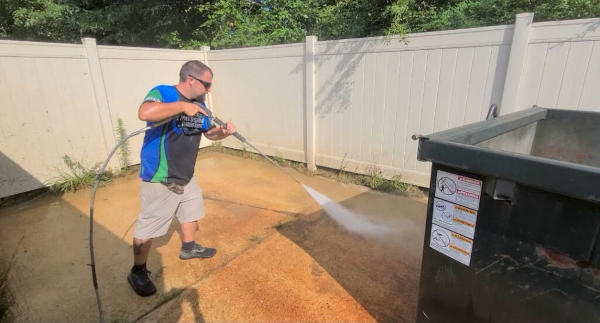
Trash enclosures and dumpster pads are easily some of the dirtiest and most unpleasant areas on any property—whether it’s residential, commercial, or industrial. Over time, these spaces accumulate grime, grease, rotting organic matter, bacteria, and foul odors that not only attract pests but also pose health and sanitation risks. Power washing is one of the most effective ways to clean these areas quickly, thoroughly, and safely.
In this article, we’ll walk you through how to power wash dumpster areas and trash enclosures to remove stains, kill germs, and eliminate odors—without damaging nearby surfaces or violating health codes.
🚮 Why It’s Important to Keep These Areas Clean
Most people try to avoid looking too closely at their dumpster or trash pad areas—but that doesn’t mean they should be ignored. Dirty trash zones can lead to:
- Foul odors that impact nearby residents or customers
- Rodent and insect infestations 🐀🪰
- Slip and fall hazards from grease and spilled liquids
- Health violations for commercial properties
- Damage to concrete or asphalt over time
- A major eyesore that brings down property appearance
Whether you’re a homeowner, property manager, or business owner, keeping these zones clean is a must. And there’s no better tool for the job than a pressure washer.
✅ What You’ll Need
- Pressure washer (minimum 3,000 PSI for commercial-grade grime)
- 15° or 25° spray nozzle tip
- Heavy-duty degreaser or disinfecting cleaner
- Push broom or stiff scrub brush
- Trash bags, gloves, and safety goggles 🧤👓
- Wet/dry vacuum or squeegee (optional for water control)
- Tarps or barriers (to contain runoff)
- Hose for rinsing
- Optional: hot water pressure washer for greasy pads
Browse Amazon Here For Top Rated Power Washers And Accessories
🧽 Step-by-Step Guide to Cleaning Dumpster Areas
1. Clear the Area
- Remove all loose trash, boxes, and debris
- Use a broom or rake to clear solid waste
- Wear gloves—there may be broken glass or sharp objects
2. Pre-Treat with Degreaser or Disinfectant
Apply a heavy-duty degreaser or bacteria-killing cleaner to the entire area, including:
- Concrete or asphalt pads
- Dumpster doors or enclosures
- Walls or gates surrounding the enclosure
- Any metal rails or supports
Let the cleaner dwell for 10–15 minutes to break down oils, food residue, and grime. Reapply to any especially greasy spots.
💡 If you have a hot water pressure washer, you’ll get even better results on oily buildup.
3. Use the Right Nozzle
Attach a 15° or 25° nozzle—these provide enough pressure to blast away tough stains without damaging the concrete. For very stubborn grease or hardened residue, a turbo nozzle may be used cautiously.
Keep the tip 6–12 inches above the surface and move in overlapping sweeps.
4. Work from Back to Front
Always wash from the farthest point inward toward the drain or runoff exit. This ensures:
- Dirty water doesn’t run over cleaned areas
- You direct wastewater toward a contained drainage area
- You don’t track bacteria back through the cleaned surface
Use a push broom to direct pooled water if necessary.
5. Focus on Stains and Crevices
Stains tend to settle into cracks, expansion joints, and corners:
- Use a scrub brush or wire broom for corners
- Spend extra time where the dumpster wheels rest—these spots often leak oil or fluids
- Don’t forget to spray down metal rails or enclosure walls
6. Rinse and Recover Water
Once clean:
- Rinse thoroughly with clean water
- Use a wet/dry vac or squeegee to collect wastewater
- Dispose of water according to local waste disposal guidelines
💧 Some cities have strict rules about wastewater runoff—make sure you’re compliant!
🌿 Sanitation and Odor Control Tips
- Use enzymatic cleaners that digest organic matter and reduce smell
- Sprinkle baking soda or lime powder after cleaning to neutralize odors
- Install drain covers or mats to prevent future clogs
- Power wash monthly during hot months or high-trash periods
⚠️ Safety and Environmental Concerns
- Always wear gloves and goggles
- Avoid harsh chemical runoff near storm drains or landscaping
- Block off the area while cleaning—slippery surfaces can be dangerous
- If you’re a commercial business, make sure your cleaning methods meet local health codes
🧠 Additional Tips for Property Managers
- Schedule cleanings after trash pickup for best results
- Offer maintenance packages to commercial tenants
- Include dumpster pad cleaning in lease agreements or service contracts
- Install signs reminding tenants to close lids and avoid overflow
💬 Final Thoughts
Trash enclosures and dumpster areas might not be glamorous, but they’re essential to property hygiene and presentation. Regular power washing keeps pests, odors, and violations at bay while improving the look and feel of your property.
With the right tools, techniques, and schedule, you can keep these problem zones clean, sanitary, and odor-free—all without breaking a sweat 💪🧼🗑️.
Browse Amazon Here For Top Rated Power Washers And Accessories



